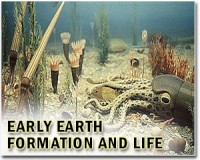 |
Chicago (UPI) Dec 21, 2010 Many dinosaur species long considered strictly meat-eaters may have evolved into plant eaters at some point in their history, U.S. scientists say. Researchers at Chicago's Field Museum say velociraptors and Tyrannosaurus rex, two-legged dinosaurs known as theropods, were definitively carnivores but the diet of their direct ancestors took some surprising turns over the years, the Chicago Tribune reported Tuesday. Through tens of millions of years of evolution some shifted away from a meat diet, becoming herbivores or omnivores, which eat both plants and meat, their study appearing in the Proceedings of the National Academy of Sciences says. "Most theropods are clearly adapted to a predatory lifestyle, but somewhere on the line to birds, predatory dinosaurs went soft," Lindsay Zanno, a Field Museum postdoctoral student, says. "Our common historical image of theropods is out of date." A handful of theropod species, including the direct genetic ancestors of velociraptors, went from eating meat to plant diets and then inexplicably returned to meat diets after millions of years, the researchers say. Of 90 theropod species studied, 44 yielded evidence of being either exclusive plant-eaters or omnivores, Zanno says. Changes in flora, fauna and geography caused theropods to turn away from the violence of hunting and assume the gentler activity of browsing for plants for their food, she says. The changes seem to coincide with the period when flowering plants first appeared and spread across the world, as well as when the continents split and moved apart from each other, creating new ecological niches for animals to exploit and occupy, she says.
Share This Article With Planet Earth
Related Links Explore The Early Earth at TerraDaily.com
 Scientists track ancient gene 'explosion'
Scientists track ancient gene 'explosion'Boston (UPI) Dec 21, 2010 U.S. researchers say an explosion of new genes more than 3 billion years ago created about a quarter of today's DNA blueprint of all life. Scientists at the Massachusetts Institute of Technology say about 27 percent of all gene families that exist today were born between 3.3 billion and 2.8 billion years ago, ScienceNews.org reported Tuesday. The surge of gene births, dubbed the ... read more |
|
| The content herein, unless otherwise known to be public domain, are Copyright 1995-2010 - SpaceDaily. AFP and UPI Wire Stories are copyright Agence France-Presse and United Press International. ESA Portal Reports are copyright European Space Agency. All NASA sourced material is public domain. Additional copyrights may apply in whole or part to other bona fide parties. Advertising does not imply endorsement,agreement or approval of any opinions, statements or information provided by SpaceDaily on any Web page published or hosted by SpaceDaily. Privacy Statement |